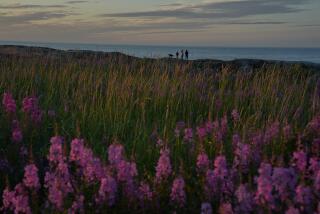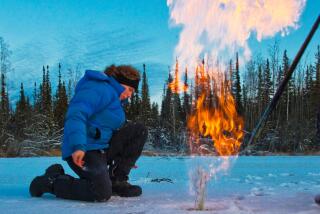Destination: Quebec : Where Winter Works : Why go to Canada in February? Quebec’s carnival provides a historic venue for celebrating the big chill.
- Share via
QUEBEC CITY, Canada — Perched on a cliff overlooking the St. Lawrence River, Quebec City appears from a distance like a vision from a Hans Christian Andersen fairy tale.
Cloaked in a mantle of snow and trimmed in glistening icicles, rows of steep-roofed, stone row houses climb along a warren of narrow cobbled streets to a crowning castle that bristles with copper-roofed turrets. Yet when I am within the city’s embrace, walking those narrow medieval streets, a frosty wind nipping at my ears, the words that come to mind are not those of a fairy tale, but of Quebec’s most famous contemporary poet, Gilles Vigneault, who wrote, “My country is not a country, it is winter . . . “
For the record:
12:00 a.m. Feb. 6, 1994 For the Record
Los Angeles Times Sunday February 6, 1994 Home Edition Travel Part L Page 6 Column 6 Travel Desk 1 inches; 29 words Type of Material: Correction
Clarification--In the accompanying Guidebook for the Jan. 30 story “Where Winter Works,” Air Canada’s round-trip air fare between LAX and Quebec was listed as $632. There is a cheaper fare of $504 available.
Nothing could be truer of Quebec City when it is locked in the jaws of ice and snow.
Why, then, would anyone dream of heading north to Canada in February? For the five years I have lived in Montreal--150 miles southwest of Quebec City--I have rarely missed an opportunity to visit the city’s pre-Lenten carnival celebration, not just for the planned events, but to join the locals and others from around the world in welcoming winter’s chill full on, during an 11-day frozen Mardi Gras.
From Feb. 3 to 13 this year, the Carnaval de Quebec is a full calendar of dog sled races, ice canoeing competitions and--for those, unlike me, with iron constitutions--outdoor “snow baths,” which means taking a tumble in frozen powder dressed in only a swimming suit. I do, however, bring my own skates for a modest little whirl around the outdoor rinks--some set up especially for carnival in parks and along the St. Lawrence River. For those with confidence enough, there is organized barrel jumping on skates. (I take a pass on this.) Even horses don spiked shoes to race on the ice of the frozen Charles River. So I bundle up, stomp my feet to the rhythm of a French Canadian jig being played over loudspeakers and watch in astonishment as the Quebeckers’ famous joie de vivre expresses itself in various ways including dancing in the streets, despite temperatures that may hover near 10 degrees.
Quebec, as the city is usually known, is home to 500,000 people. But within the modern metropolis beats an ancient and still vigorous heart locals call “Vieux Quebec,” Old Quebec. Through 4 1/2 centuries, this exquisite half-square-mile of European ambience, brimming with more than 3,000 historic buildings, has aged like fine French cognac. Cradled by massive granite and sandstone ramparts, it is the only walled city north of Mexico.
Modern Quebec grew up outside these walls and though the historic district fell into substantial disrepair, it was not razed, as city centers elsewhere were. Instead, during the 1960s and ‘70s, people began moving back into the old quarter, restoring whole streets and infusing them once again with life. Finally, in 1985 UNESCO declared Old Quebec a World Heritage Site, the first city in North America to join the designation that also includes Jerusalem, the Taj Mahal and the Pyramids. Most of the festivities of carnival take place in and around Old Quebec.
Watching the events or prowling the warren of winding streets in the old city, I soon feel the winter chill making its way through my parka and boots--the perfect excuse to duck into one of the many cafes or pastry shops on the main shopping streets of rue St. Louis and rue St. Jean. In the true French style, most establishments post their menus outside beneath the light of Victorian street lamps and temptingly display their pastries and cakes in the windows, making them all the more difficult to resist.
Quebec food is a specialty that is hard to find elsewhere. I have a soft spot for this hearty cuisine that was created with winter in mind: pea soup rich with smoked ham chunks, maple sugar sweetened baked beans, tourtiere, a main course pie made from a selection of game meats, and sinfully decadent maple syrup pie served warm and topped with whipped cream.
Being rather sentimental, I find one of the nicest ways to explore Old Quebec during carnival to be from the comfort of a caleche, wrapped in a cozy fur rug as my driver, his curling mustache sparkling with ice crystals, directs the horse-drawn carriage past beautiful, Notre-Dame-de-Quebec cathedral, past Quebec Seminary, one of the first universities in North America, and past the bustling cobblestone pedestrian street rue de Tresor--a narrow sliver of Paris’ Montmartre, where artists hang their sketches and paintings outdoors for sale even in the depths of winter.
Dry snow scrunches under my feet on the broad wooden boardwalk of Dufferin Terrace that skirts the Chateau Frontenac, one of Canada’s grand railway hotels built in 1893. Although I had to book six months in advance of my 1993 carnival visit, staying at the Chateau, with its old English Tudor interior and spectacular views of the city, was truly romantic.
Throughout the crooked maze of streets I have found surprises at almost every turn by asking the question: “What did this used to be?” Everyone, from waiters to workmen, suddenly becomes an amateur historian, in the city where it seems everything was once something else. One day my lunch is served in La Couchon Dingue, which turns out to be a former 19th-Century police station. On another, in the Pape George (Pope George), a cozy wine bar with low-beamed ceilings and three-foot-thick walls, the barman opens a thick portfolio of engravings he plucks from beneath the counter to show me the place as a fur store dating back to the 1750s.
With a furry bearhug I meet Bonhomme, carnival’s master of ceremonies and mascot--a jolly snowman wearing a red toque and braided sash of the hearty hommes du nord-- men of the north--whose intrepid pioneering spirit has been the inspiration for carnival since it began in 1954. Bonhomme’s residence is in the 75-foot-high palace made of snow blocks that is carnival’s centerpiece. And it’s here, just outside medieval St. Louis Gate, that I grab a toboggan and slide down the icy incline that takes me in a breathtaking whoosh, from the top of the castle to the ground, perhaps 40 feet below.
Bonhomme’s smiling countenance also appears on the tops of hollow carnival canes that are filled with a traditional brew of red wine and spirits that make a blend called Caribou. The concoction--which carries the kick of its namesake--helped the early explorers stay warm, a role it still performs each year at carnival where it is illegal to drink from a bottle outdoors but acceptable to tip the cane for a sip.
Carnival spills outside the old city walls and down nearby Grande Allee, a broad and elegant avenue of Victorian stone row houses converted to stylish restaurants. It’s here I head to watch entrants from a dozen countries take part in the International Snow Sculpture Competition, where they chip and saw away at great blocks of ice from which emerge a fantastic repertoire of serpents, polar bears, a Statue of Liberty, larger than life Eskimos and an entire family on a giant sled.
Stomping my feet and slapping my hands together to keep warm, I await the grand finale of the festival, the two-mile-long canoe race across the ice choked St. Lawrence River to Levis on the south bank and back. Ice canoeing is a traditional sport that was once the only means of transport to many islands in the river during winter. As an ice breaker travels to and fro to keep a pathway open, the starting gun sends the five-man team off, alternately rowing with long oars in open water or running across the bluish ice slabs with metal crampons on their shoes.
A little over 30 minutes later, I am still among thousands of spectators stoically lining the river banks to cheer as the first boat touches the shoreline. In true hommes du nord style the winning team does a victory leap, almost making my own heart stop as they plunge backward into the cold thickening waters. I swear I feel a shiver pass through the crowd.
That evening carnival draws to a close with a spectacular candlelight parade winding through the streets. Sure it’s cold outside watching the glittering floats pass by, but there’s been something in the air these past 11 days: a gaiety and sense of celebration that truly warms the heart.
GUIDEBOOK
Quebec Winter
Getting there: Northwest (about $590) and Air Canada (about $632) offer connecting flights from LAX to Quebec.
Where to stay: Chateau Frontenac, about $75 to $640 for a suite; (418) 692-3861.
Hotel Manoir d’Auteuil, about $40 to $95; (418) 694-1173.
Le Chateau de Pierre, about $60 to $80; (418) 694-0429.
Where to eat: A la table de Serge Bruyere, 1200 rue St. Jean; (418) 694-0618.
Cafe de la Paix, 44 Desjardins; (418) 692-1430.
Aux Anciens Canadiens, 34 rue St. Louis; (418) 692-1627.
For further information: Tourisme Quebec, P.O. Box 979, Montreal, H3C2 W3 Quebec; (800) 363-7777.
More to Read
Sign up for The Wild
We’ll help you find the best places to hike, bike and run, as well as the perfect silent spots for meditation and yoga.
You may occasionally receive promotional content from the Los Angeles Times.






